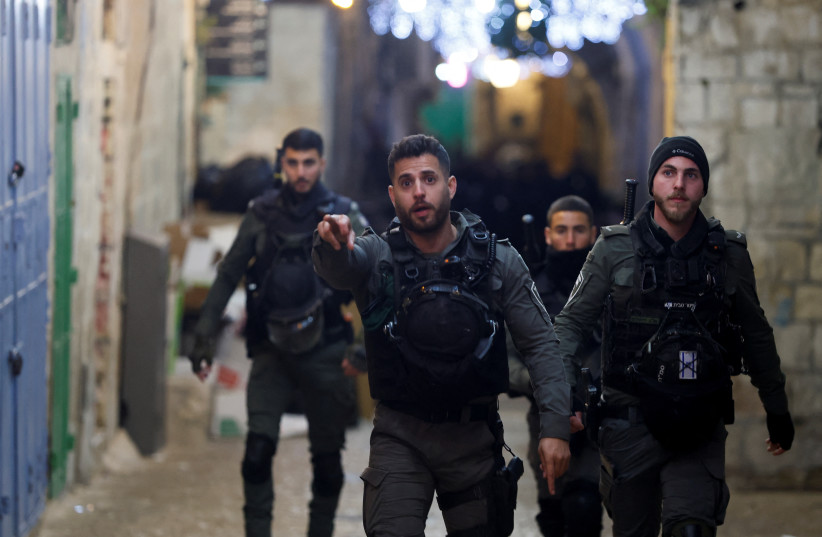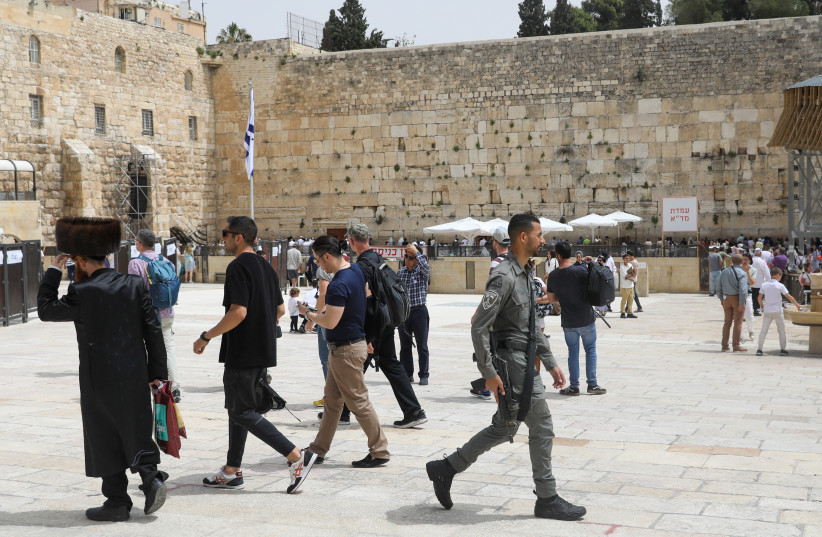Jerusalem filled with three holiday celebrations at once

Various colorful publications are scattered in every corner with the same subject: messianism, and the importance of the temple and its construction soon in our day.
Three families were standing near the shuttle station by the parking lot of the First Station outside of Jerusalem’s Old City, wondering if the shuttle to the Western Wall was running. The signboard said that details can be obtained at the 106 municipality hotline, which turned out to be closed due to the holiday.
A skinny young man offers them a free ride to the City of David, right outside the Dung Gate into the Western Wall compound. “Are you stopping at the Kotel?” asks the father of one of the families. “I’m not allowed; policemen only allow a stop at the entrance to the City of David, but it’s not far, only a short climb” – which turned out to be a steep climb until the gate.
The first thing that stands out is a large number of policemen and Magav security personnel. In pairs, in groups; near the gate, inside the gate, at the entrance to the Western Wall security checkpoint and around the path leading up to the Mograbim Gate – from where Jews are allowed to visit the Temple Mount. According to publications of the temple organizations, over a thousand ascended on the first morning that the police allowed.
At the entrance to the square,14-year-old Dror sits on a large stone and invites visitors to a free guided tour of the Yemenite village. There are already 40 families there. “We have a strong army that protects us; it is very good for us there.” Various colorful publications are scattered in every corner with the same subject: messianism, and the importance of the temple and its construction soon in our day.
The four-quarters of Jerusalem's Old City

THE HAZE competes with the heat and the entrance to the plaza; cold water and plastic cups are offered, courtesy of the Western Wall Heritage Foundation. The sight in the square is the most colorful and diverse thing imaginable. Haredim in fancy black kaftans and furry shtreimels on their heads, next to hassidim in holiday clothes made of golden fabrics and crisp white socks; tourists dressed in a mixture of “secular” clothes with shawls thrown on the women’s shoulders for a more modest look. “Shawls” women, dressed in black from head to toe, wrapped so that only their face is exposed, push baby carriages surrounded by their little ones.
Along the passage of the security forces at the top of the square, next to the entrance to the Western Wall tunnels, people sit on the ground, waiting and staring at the impressive wall. Suddenly, a group of police commanders in uniform come out of the tunnel area, all speaking to their mobile phones, with a somewhat serious expression on their faces.
The area is divided into separate entrances for men and women; near one of the entrances, a group of Ethiopians, holding their colorful umbrellas, are praying in the Ghez language, surrounded by dozens of members of the community.
Former minister Pnina Tamano-Shata is standing there, next to her elderly mother who won a seat. She tells about an ancient tradition that the kais (Ethiopian rabbis and spiritual leaders) pray for peace and brotherhood for the entire congregation on the days of Passover, adding that the training of young kais lasts up to seven years, under difficult conditions. “Yes, thank God, there is a revival,” she says, “and there are many young people who join and keep the tradition.”
The traditional blessing of the priests (Birkat Cohanim) is over, as is the call for midday Muslim prayer from al-Aksa Mosque – and by now, groups of Christian pilgrims are beginning to arrive at the square, with guides who explain in a mixture of languages. A group of Bnei Menashe of the Indian subcontinent, stands nearby and listens to the same explications; a group of Christian Indians, their women dressed in colorful traditional sarees and wearing crosses made of gold.
The stairs lead from the wall to the market, with policemen every few meters. Many shops in the market are closed; some are open, but it is evident that the movement of shoppers is very weak. Restaurants, falafel stands and more are empty of customers – “They don’t buy anything ma’am” a souvenir shop owner who is sitting outside his shop tells me, in a kind of peaceful desperation. Two of his neighbors up the alley try to say, in reasonable Hebrew, “Happy Holidays” in the hope that it might attract buyers, but in vain.
Turn right and there is the market of the Christian Quarter. Here there is a little more traffic of buyers – Christian pilgrims who purchase religious goods. Moristan Square is already busier; the cafes and restaurants are full of diners, and near the entrance to the Church of the Redeemer, there is already a large crowd. Through a narrow and low passage is the square of the Church of the Sepulchre. A view from above towards Via Dolorosa indicates that the pilgrims carrying the heavy cross have not yet arrived – Easter is tomorrow, Monday.
Here the number of visitors is the largest this morning, standing in line to enter. In the upper square, slightly hidden from the blazing sun, a Greek woman named Clara is filming live and chatting on WhatsApp with her loved ones in Greece. “Hronia pola” (happy birthday) I tell her, congratulating her for many years of holidays, and she smiles. At the exit of the Jaffa Gate, large groups of policemen again rush to reach the entrance. In a niche in the wall, two ultra-Orthodox youths are sitting and playing a section from “Jerusalem of Gold” to a mixed audience of Arabs, Christians and Jews of all affiliations.
Jerusalem was calm Sunday morning, despite the difficult events of the last few days.
Jerusalem Post Store
`; document.getElementById("linkPremium").innerHTML = cont; var divWithLink = document.getElementById("premium-link"); if (divWithLink !== null && divWithLink !== 'undefined') { divWithLink.style.border = "solid 1px #cb0f3e"; divWithLink.style.textAlign = "center"; divWithLink.style.marginBottom = "15px"; divWithLink.style.marginTop = "15px"; divWithLink.style.width = "100%"; divWithLink.style.backgroundColor = "#122952"; divWithLink.style.color = "#ffffff"; divWithLink.style.lineHeight = "1.5"; } } (function (v, i) { });

